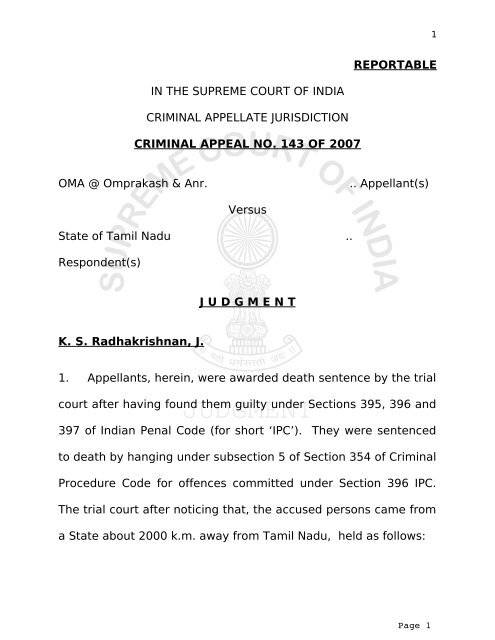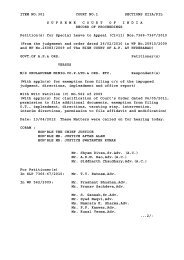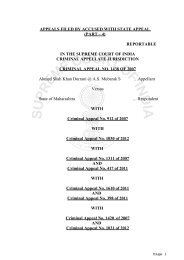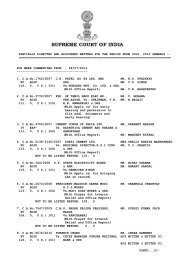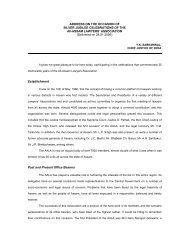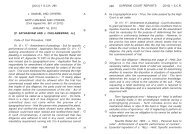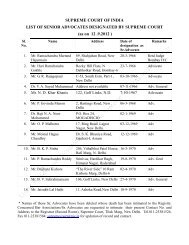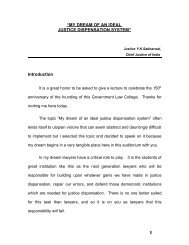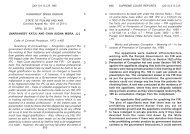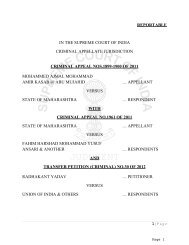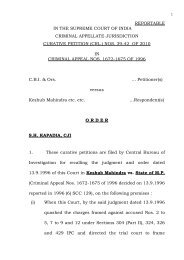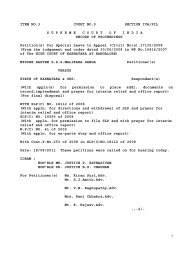JUDGMENT in Criminal Appeal No. 143/2007 - Supreme Court of ...
JUDGMENT in Criminal Appeal No. 143/2007 - Supreme Court of ...
JUDGMENT in Criminal Appeal No. 143/2007 - Supreme Court of ...
- No tags were found...
Create successful ePaper yourself
Turn your PDF publications into a flip-book with our unique Google optimized e-Paper software.
3Accused <strong>No</strong>s. 1 and 2 under Sections 395, 396 and 397 IPC wereconfirmed but the sentence under Section 396 IPC was modifiedto that <strong>of</strong> life imprisonment <strong>in</strong>stead <strong>of</strong> death sentence. Aga<strong>in</strong>stwhich, accused <strong>No</strong>s. 1 and 2 came up with this appeal. While thisappeal was pend<strong>in</strong>g, the first appellant (A1) died and the secondappellant (A2) has prosecuted this appeal.4. The prosecution case is as follows:The appellants and n<strong>in</strong>e other abscond<strong>in</strong>g accused personsentered the house <strong>of</strong> one Lakshmi (PW 2) at 1 O’ clock <strong>in</strong> thenight <strong>of</strong> 07.06.1995 with the <strong>in</strong>tention <strong>of</strong> committ<strong>in</strong>g burglary withiron rods <strong>in</strong> their hands and burgled 17 tolas <strong>of</strong> gold andRs.5,000/- <strong>in</strong> cash. In that process, it was alleged that they hadstrangulated Doctor Mohan Kumar, husband <strong>of</strong> PW 2 with a ropeand thereby killed him. It was alleged that the accused assaultedPW 2, her son Sudhakar (PW 5) and other son Sakthivel (PW 6).While escap<strong>in</strong>g, they had also attacked Borm<strong>in</strong> Varghese (PW 1)with iron rod. FIR Cr. <strong>No</strong>. 403 <strong>of</strong> 1995 under Sections 396, 397IPC was registered at 5.30 am on 07.06.1995 at Police StationWalajapet on the statement <strong>of</strong> one Patrick Varghese recorded byPage 3
57. The prosecution exam<strong>in</strong>ed 15 witnesses to prove the caseaga<strong>in</strong>st the accused persons. Statements <strong>of</strong> the accused personswere recorded under Section 313 Cr.P.C. on 17.04.2006.8. The trial court, as already <strong>in</strong>dicated, convicted both theaccused persons on 21.04.2006 for the <strong>of</strong>fences under Sections395, 396 and 397 IPC. The trial court granted life imprisonmentunder Section 395 and f<strong>in</strong>e <strong>of</strong> Rs.1,000/- and they were sentencedto death for the <strong>of</strong>fence under Section 396 IPC. They were alsosentenced for RI for 7 years under Section 397 IPC.9. The High <strong>Court</strong>, as already <strong>in</strong>dicated, vide judgment dated27.07.2006 converted the sentence <strong>of</strong> death to life imprisonmentunder Section 396 IPC and rest <strong>of</strong> the sentence on other headswere confirmed.10. Shri Sanjay Ja<strong>in</strong>, learned counsel appear<strong>in</strong>g for the appellant(A2) submitted that the trial court and the High <strong>Court</strong> hadcommitted a grave error <strong>in</strong> convict<strong>in</strong>g the accused persons.Learned counsel challenged his conviction ma<strong>in</strong>ly on two grounds:one on the ground <strong>of</strong> non-conduct<strong>in</strong>g the identification parade soPage 5
11Accord<strong>in</strong>gly this judgment should be. Therefore, thiscourt is <strong>of</strong> the view that the death sentence should beimposed on the accused.”(emphasis added)14. We cannot countenance any <strong>of</strong> the reasons which weighedwith the Sessions Judge <strong>in</strong> award<strong>in</strong>g the death sentence. Reasonsstated <strong>in</strong> para 36(b) and (e) <strong>in</strong> award<strong>in</strong>g death sentence <strong>in</strong> thiscase exposes the ignorance <strong>of</strong> the learned judge <strong>of</strong> the crim<strong>in</strong>aljurisprudence <strong>of</strong> this country.15. Section 354(3) <strong>of</strong> the Code states whenever a <strong>Court</strong> awardsdeath sentence, it shall record special reasons. Go<strong>in</strong>g by thecurrent penological thought, imprisonment <strong>of</strong> life is the rule anddeath sentence is an exception. The legislator’s <strong>in</strong>tent beh<strong>in</strong>denact<strong>in</strong>g Section 354(3) clearly demonstrates the concern <strong>of</strong> thelegislature.This pr<strong>in</strong>ciple has been highlighted <strong>in</strong> severaljudgments <strong>of</strong> this <strong>Court</strong> apart from the judgments alreadyreferred to. Reference may also be made to few <strong>of</strong> the judgments<strong>of</strong> this <strong>Court</strong>, such as Ronal James v. State <strong>of</strong> Maharashtra,(1998) 3 SCC 625; Allaudd<strong>in</strong> Mian v. State <strong>of</strong> Bihar, (1989) 3SCC 5; Naresh Giri v. State <strong>of</strong> M.P., (2001) 9 SCC 615 etc. WePage 11
13penalty, four dissented and the <strong>Court</strong> held that death penalty tobe cruel and unusual punishment <strong>in</strong> violation <strong>of</strong> the 8 th and 14 thamendments. Later <strong>in</strong> Gregg v. Georgia [ 428 U.S. 153(1976)], the court laid down the concern expressed <strong>in</strong> Furman.In the United States, some States have done away with deathsentence as well.The judges’ <strong>in</strong>cl<strong>in</strong>ation to br<strong>in</strong>g <strong>in</strong> allegedsystem <strong>of</strong> lynch<strong>in</strong>g to India and to show it as special reason isunfortunate and shows lack <strong>of</strong> exposure to crim<strong>in</strong>al laws <strong>of</strong> thiscountry.Learned trial judge while show<strong>in</strong>g special reasonsreferred to law prevail<strong>in</strong>g <strong>in</strong> Arab countries, like impos<strong>in</strong>gsentence <strong>of</strong> ‘slashn<strong>in</strong>g’ behead<strong>in</strong>g, tak<strong>in</strong>g organ for organ like“eye for eye”, “tooth for tooth” and says those are thedevelopments <strong>of</strong> crim<strong>in</strong>al jurisprudence. Learned judge then saysthat the accused persons <strong>in</strong> the present case also deserve deathsentence. Learned judge lost sight <strong>of</strong> the fact that the Crim<strong>in</strong>alJurisprudence <strong>of</strong> this country or our society does not recognizethose types <strong>of</strong> barbaric sentences. We are surprised to see howthose factors have gone <strong>in</strong>to one’s m<strong>in</strong>d <strong>in</strong> award<strong>in</strong>g deathsentence.Page 13
1620. We also fail to see how the reasons stated <strong>in</strong> para 36(f) be aguid<strong>in</strong>g factor to award death sentence.One <strong>of</strong> the Code <strong>of</strong>Conduct recognized at the Bangalore Conference <strong>of</strong> the year 2001reads as follows:“A judge shall exercise the judicial function<strong>in</strong>dependently on the basis <strong>of</strong> the judge’s assessment<strong>of</strong> the facts and <strong>in</strong> accordance with a conscientiousunderstand<strong>in</strong>g <strong>of</strong> the law, free <strong>of</strong> any extraneous<strong>in</strong>fluences, <strong>in</strong>ducement, pressures, threats or<strong>in</strong>terference, direct or <strong>in</strong>direct, from any quarter or forany reason.”21. Crim<strong>in</strong>al <strong>Court</strong> while decid<strong>in</strong>g crim<strong>in</strong>al cases shall not beguided or <strong>in</strong>fluenced by the views or op<strong>in</strong>ions expressed byJudges on a private platform. The views or op<strong>in</strong>ions expressed bythe Judges, jurists, academicians, law teachers may be food forthought. Even the discussions or deliberations made on the StateJudicial Academies or National Judicial Academy at Bhopal, onlyupdate or open new vistas <strong>of</strong> knowledge <strong>of</strong> judicial <strong>of</strong>ficers.Crim<strong>in</strong>al <strong>Court</strong>s have to decide the cases before them exam<strong>in</strong><strong>in</strong>gthe relevant facts and evidence placed before them, apply<strong>in</strong>gb<strong>in</strong>d<strong>in</strong>g precedents. Judges or academicians op<strong>in</strong>ions,Page 16
17predilection, fondness, <strong>in</strong>cl<strong>in</strong>ation, proclivity on any subject,however em<strong>in</strong>ent they are, shall not <strong>in</strong>fluence a decision mak<strong>in</strong>gprocess, especially when judges are called upon to decide acrim<strong>in</strong>al case which rests only on the evidence adduced by theprosecution as well as by the defence and guided by settledjudicial precedents. National Judicial Academy and State JudicialAcademies should educate our judicial <strong>of</strong>ficers <strong>in</strong> this regard sothat they will not commit such serious errors <strong>in</strong> future.22. The High <strong>Court</strong> <strong>of</strong> Madras heard the Crim<strong>in</strong>al <strong>Appeal</strong> <strong>No</strong>.566/2006 filed by the accused <strong>No</strong>s. 1 and 2, along with ReferredTrial 1 <strong>of</strong> 2006. The High <strong>Court</strong>, however, did not confirm thedeath sentence awarded by the trial <strong>Court</strong>, but awarded lifesentence to both the accused persons. As already <strong>in</strong>dicated, weare, <strong>in</strong> this case, concerned only with the conviction and sentenceawarded on the 2 nd accused, s<strong>in</strong>ce 1 st accused is no more.23. We may <strong>in</strong>dicate at the outset that the accused personswere apprehended after a period <strong>of</strong> ten years from the date <strong>of</strong> the<strong>in</strong>cident and n<strong>in</strong>e other accused persons are still abscond<strong>in</strong>g. The<strong>in</strong>cident had taken place on 07.06.1995 and the accused personsPage 17
18were arrested on 26.02.2005 from Rajasthan <strong>in</strong> connection withsome other case ie. Cr. <strong>No</strong>. 59 <strong>of</strong> 1996. The prosecution versionthat A-2 f<strong>in</strong>ger pr<strong>in</strong>ts tallied with ones lifted from the place <strong>of</strong>occurrence <strong>in</strong> Cr. <strong>No</strong>. 59 <strong>of</strong> 1996.Further, it is also theprosecution case that A2 made a disclosure and pursuant to thatiron rod (M.O. <strong>No</strong>.1) used 10 years back was recovered.Anidentification parade was conducted so far as A1 is concerned on20.10.2005, who is now no more. However, no identificationparade was conducted so far as A-2 is concerned. It has come out<strong>in</strong> evidence that the photographs <strong>of</strong> A-2 was shown to PW 1 bythe police on 30.10.2005 and asked him to identify the accusedand on identification by PW 1, the accused was <strong>in</strong>terrogated bythe police. In cross-exam<strong>in</strong>ation, PW1 has stated as follows:“Accused <strong>No</strong>.2 attacked me before I could see himand make any enquiry. He assaulted me with a rod.I could not see with which hand he assaulted me. Itis <strong>in</strong>correct to suggest that the accused did notassault me as stated by me.”24. PW 1 also further stated <strong>in</strong> cross-exam<strong>in</strong>ation as follows:“There was light only after the neighbors switched onthe light. It was dark earlier. It is <strong>in</strong>correct to suggestthat it is not possible to see the accused <strong>in</strong> thedarkness.”Page 18
1925. PW 2 – Lakshmi, wife <strong>of</strong> the deceased <strong>in</strong> her exam<strong>in</strong>ation-<strong>in</strong>chiefstated as follows:“I opened my eyes and saw. When I saw, accused<strong>No</strong>s. 1 and 2 were present amongst the persons. Ifa<strong>in</strong>ted immediately. There was commotion <strong>in</strong> myhouse.”26. In cross-exam<strong>in</strong>ation, she has stated as follows:“In the police <strong>in</strong>terrogation, I did not tell that theaccused <strong>No</strong>s. 1 and 2 were present <strong>in</strong> the <strong>in</strong>cidentthat took place <strong>in</strong> my house.”27. PW 5, brother <strong>of</strong> PW 1, <strong>in</strong> his exam<strong>in</strong>ation-<strong>in</strong>-chief has statedas follows:“At that time accused <strong>No</strong>s. 1 and 2 attacked me withthe rod. I fell down and fa<strong>in</strong>ted. When I rega<strong>in</strong>edconsciousness I was <strong>in</strong> the room <strong>of</strong> my father. Myfather, my mother and younger brother susta<strong>in</strong>ed<strong>in</strong>juries. I asked my mother to wake up my father.Myself and my mother tried to wake up my father.After that neighbors admitted us <strong>in</strong> the hospital. Iremember it was <strong>in</strong> the C.M.C. hospital. The accusedattacked me similar rod that is be<strong>in</strong>g showed to me byyou. Material object <strong>No</strong>. 1 is the rod.”28. In cross-exam<strong>in</strong>ation, PW 5 stated as follows:“In the police enquiry I told that I did not know whathappened as I was sleep<strong>in</strong>g. I do not rememberwhether I told the doctor <strong>in</strong> the hospital at Valajah thatI was assaulted by unknown persons……………….In thepolice <strong>in</strong>terrogation, I did not tell that I had seen theaccused <strong>No</strong>. 1 and 2…………….”Page 19
2029. The <strong>in</strong>vestigation <strong>of</strong>ficer stated that he did not receive anydocuments about the arrest <strong>of</strong> the appellant (A2) and he had notmentioned <strong>in</strong> the f<strong>in</strong>al report about the crimes that had takenplace <strong>in</strong> other States.30. We may <strong>in</strong>dicate that <strong>in</strong> the <strong>in</strong>stant case, FIR was registeredaga<strong>in</strong>st unknown persons. A2, as already stated, was arrestedafter ten years on 26.02.2005 <strong>in</strong> connection with some othercrime. We fail to see how PW1 and PW2 could identify A2 <strong>in</strong> thecourt at this distance <strong>of</strong> time.They were guided by thephotographs repeatedly shown by the police.31. Evidently, the witnesses did not know the accused earlier,hence the accused could be identified only through a testidentification parade which was not done <strong>in</strong> this case, so far as A-2 is concerned. In this connection, we may refer to thejudgment <strong>of</strong> this court <strong>in</strong> Mohd. Iqbal M. Shaikh v. State <strong>of</strong>Maharashtra (1998) 4 SCC 494 where<strong>in</strong> this <strong>Court</strong> held that:“If the witness did not know the accused persons byname but could only identify from their appearancethen a test identification parade was necessary, soPage 20
21that, the substantive evidence <strong>in</strong> court about theidentification, which is held after fairly a long periodcould get corroboration from the identificationparade. But unfortunately the prosecution did nottake any steps <strong>in</strong> that regard and no testidentification parade had been held.”32. This <strong>Court</strong> <strong>in</strong> Rav<strong>in</strong>dra Alias Ravi Bansi Gohar v. State<strong>of</strong> Maharashtra and Others (1998) 6 SCC 609 deprecated thepractice <strong>of</strong> show<strong>in</strong>g the photographs for <strong>in</strong>dentify<strong>in</strong>g the culpritsand held as follows:“The identification parade belongs to the<strong>in</strong>vestigation stage and they serve to provide the<strong>in</strong>vestigat<strong>in</strong>g authority with materials to assurethemselves if the <strong>in</strong>vestigation is proceed<strong>in</strong>g on theright l<strong>in</strong>es. In other words, it is through theseidentification parades that the <strong>in</strong>vestigat<strong>in</strong>g agencyis required to ascerta<strong>in</strong> whether the persons whomthey suspect to have committed the <strong>of</strong>fence were thereal culprits – and not by show<strong>in</strong>g the suspects ortheir photographs. Such be<strong>in</strong>g the purpose <strong>of</strong>identification parades, the <strong>in</strong>vestigat<strong>in</strong>g agency, byshow<strong>in</strong>g the photographs <strong>of</strong> the suspects whom they<strong>in</strong>tended to place <strong>in</strong> the TI parade, made it farcical.If really the <strong>in</strong>vestigat<strong>in</strong>g agency was satisfied thatPWs 2 and 12 did know the appellants from beforeand they were <strong>in</strong> fact amongst the miscreants, thequestion <strong>of</strong> hold<strong>in</strong>g the TI parade <strong>in</strong> respect <strong>of</strong> themfor their identification could not have arisen.”33. In Ravi alias Ravichandran v. State represented byInspector <strong>of</strong> Police (<strong>2007</strong>) 15 SCC 372, this <strong>Court</strong> held that:Page 21
22“A judgment <strong>of</strong> conviction can be arrived at even ifno test identification parade has been held. Butwhen a first <strong>in</strong>formation report has been lodgedaga<strong>in</strong>st unknown persons, a test identificationparade <strong>in</strong> terms <strong>of</strong> Section 9 <strong>of</strong> the Evidence Act, isheld for the purpose <strong>of</strong> test<strong>in</strong>g the veracity <strong>of</strong> thewitness <strong>in</strong> regard to his capability <strong>of</strong> identify<strong>in</strong>gpersons who were unknown to him.”34. Further, it is also held that:“It was <strong>in</strong>cumbent upon the prosecution to arrange atest identification parade. Such test identificationparade was required to be held as early as possibleso as to exclude the possibility <strong>of</strong> the accused be<strong>in</strong>gidentified either at the police station or at some otherplace by the witnesses concerned or with referenceto the photographs published <strong>in</strong> the newspaper. Aconviction should not be based on a vagueidentification.”35. A-2, it may be noted, was not named <strong>in</strong> the FIR, nor anyidentification parade was conducted to identify him by thewitnesses. It is rather impossible to identify the accused personwhen he is produced for the first time <strong>in</strong> the court i.e. after tenyears s<strong>in</strong>ce he was unknown to the witnesses. We are <strong>of</strong> the viewthat it is a glar<strong>in</strong>g defect which goes to the root <strong>of</strong> the case s<strong>in</strong>cenone <strong>of</strong> the witnesses had properly identified the accused.Page 22
2336. We may notice that it is the case <strong>of</strong> prosecution that one rodwas also used for the murder <strong>of</strong> the deceased persons <strong>in</strong> thiscase, but that rod was not recovered. One rod stated to havebeen recovered at the <strong>in</strong>stance <strong>of</strong> A2 could not be connected withthe crime.PW 5 <strong>in</strong> his exam<strong>in</strong>ation-<strong>in</strong>-chief had stated that theaccused had attacked him with a similar rod that was be<strong>in</strong>gshown to him which would <strong>in</strong>dicate that the witness could notconclusively connect the rod which was used for committ<strong>in</strong>g thecrime. Further, the rod was recovered after a period <strong>of</strong> ten years<strong>of</strong> the <strong>in</strong>cident and it is highly doubtful, whether it was used forthe commission <strong>of</strong> the <strong>of</strong>fence. Further, the prosecution case isthat a rope was used for the strangulation caus<strong>in</strong>g death to Dr.Mohan Kumar, but the rope was not recovered.37. In Dwarkadas Gehanmal v. State <strong>of</strong> Gujarat (1999) 1SCC 57, this <strong>Court</strong> has held that it is for the prosecution to provethat the object recovered has nexus with the crime. This <strong>Court</strong> <strong>in</strong>Mustkeem alias Sirajudeen v. State <strong>of</strong> Rajasthan (2011) 11SCC 724 held, “what is admissible under Section 27 <strong>of</strong> the Act isPage 23
24the <strong>in</strong>formation lead<strong>in</strong>g to discovery and not any op<strong>in</strong>ion formedon it by the prosecution.” This <strong>Court</strong> held as follows:“With regard to Section 27 <strong>of</strong> the Act, what isimportant is discovery <strong>of</strong> the material object at thedisclosure <strong>of</strong> the accused but such disclosure alonewould not automatically lead to the conclusion thatthe <strong>of</strong>fence was also committed by the accused. Infact, thereafter, burden lies on the prosecution toestablish a close l<strong>in</strong>k between discovery <strong>of</strong> thematerial object and its use <strong>in</strong> the commission <strong>of</strong> the<strong>of</strong>fence. What is admissible under Section 27 <strong>of</strong> theAct is the <strong>in</strong>formation lead<strong>in</strong>g to discovery and notany op<strong>in</strong>ion formed on it by the prosecution.”38. In this case, the prosecution could not prove that the rodrecovered has any nexus with the crime alleged to have beencommitted by A-2.We are <strong>of</strong> the view that the prosecution,therefore, could not establish the guilt <strong>of</strong> the second accusedbeyond reasonable doubt. The High <strong>Court</strong>, therefore, committeda gross error <strong>in</strong> award<strong>in</strong>g life sentence to A2.39. This appeal is, therefore, allowed and the conviction andsentence awarded to A-2 is set aside. We are <strong>in</strong>formed that theaccused has already served the jail sentence for more than eightyears now. A-2 is, therefore, set at liberty, unless he is wanted <strong>in</strong>any other case.Page 24
25…………………………………..J.(K.S. Radhakrishnan)…………………………………..J.(Dipak Misra)New Delhi,December 11, 2012Page 25
28and, <strong>in</strong> that context, it op<strong>in</strong>ed that standardisation <strong>of</strong> thesentenc<strong>in</strong>g process would tend to sacrifice at the altar <strong>of</strong> bl<strong>in</strong>duniformity, <strong>in</strong> fact, <strong>in</strong>deed there is a real danger <strong>of</strong> suchmechanical standardisation degenerat<strong>in</strong>g <strong>in</strong>to a bed <strong>of</strong>procrustean cruelty. Thereafter, the Bench proceeded to statethus:-“As Judges, we have to resist the temptation tosubstitute our own value-choices for the will <strong>of</strong> thepeople. S<strong>in</strong>ce substituted judicial “made-to-order”standards, howsoever pa<strong>in</strong>stak<strong>in</strong>gly made, do notbear the people's imprimatur, they may not have thesame authenticity and efficacy as the silent zonesand green belts designedly marked out and left openby Parliament <strong>in</strong> its legislative plann<strong>in</strong>g for fair play<strong>of</strong> judicial discretion to take care <strong>of</strong> the variable,unpredictable circumstances <strong>of</strong> the <strong>in</strong>dividual cases,relevant to <strong>in</strong>dividualised sentenc<strong>in</strong>g. When Judges,act<strong>in</strong>g <strong>in</strong>dividually or collectively, <strong>in</strong> their benignanxiety to do what they th<strong>in</strong>k is morally good for thepeople, take upon themselves the responsibility <strong>of</strong>sett<strong>in</strong>g down social norms <strong>of</strong> conduct, there is everydanger, despite their effort to make a rational guess<strong>of</strong> the notions <strong>of</strong> right and wrong prevail<strong>in</strong>g <strong>in</strong> thecommunity at large and despite their <strong>in</strong>tention toabide by the dictates <strong>of</strong> mere reason, that theymight write their own peculiar view or personalpredilection <strong>in</strong>to the law, s<strong>in</strong>cerely mistak<strong>in</strong>g thatchangel<strong>in</strong>g for what they perceive to be thePage 28
32“(i) The extreme penalty <strong>of</strong> death need not be<strong>in</strong>flicted except <strong>in</strong> gravest cases <strong>of</strong> extremeculpability.(ii) Before opt<strong>in</strong>g for the death penalty thecircumstances <strong>of</strong> the ‘<strong>of</strong>fender’ also require to betaken <strong>in</strong>to consideration along with thecircumstances <strong>of</strong> the ‘crime’.(iii) Life imprisonment is the rule and death sentenceis an exception. In other words death sentence mustbe imposed only when life imprisonment appears tobe an altogether <strong>in</strong>adequate punishment hav<strong>in</strong>gregard to the relevant circumstances <strong>of</strong> the crime,and provided, and only provided, the option toimpose sentence <strong>of</strong> imprisonment for life cannot beconscientiously exercised hav<strong>in</strong>g regard to thenature and circumstances <strong>of</strong> the crime and all therelevant circumstances.(iv) A balance sheet <strong>of</strong> aggravat<strong>in</strong>g and mitigat<strong>in</strong>gcircumstances has to be drawn up and <strong>in</strong> do<strong>in</strong>g sothe mitigat<strong>in</strong>g circumstances have to be accordedfull weightage and a just balance has to be struckbetween the aggravat<strong>in</strong>g and the mitigat<strong>in</strong>gcircumstances before the option is exercised.”10. Thereafter, the <strong>Court</strong> stated that to apply the saidguidel<strong>in</strong>es, the follow<strong>in</strong>g questions are required to be asked andanswered:-Page 32
39entitled to have, it demonstrated that the Judge has the correctpr<strong>in</strong>ciples <strong>in</strong> m<strong>in</strong>d, has properly applied them and is entitled toexam<strong>in</strong>e the body <strong>of</strong> the judgment for the learn<strong>in</strong>g and precedentthat they provide and further reassurance <strong>of</strong> the quality <strong>of</strong> thejudiciary which is the centre-piece <strong>of</strong> our adm<strong>in</strong>istration <strong>of</strong> justice.Thus, the fundamental requirement is that a Judge presid<strong>in</strong>g overa crim<strong>in</strong>al trial has the sacrosanct duty to demonstrate that heapplies the correct pr<strong>in</strong>ciples <strong>of</strong> law to the facts regard be<strong>in</strong>g hadto the precedents <strong>in</strong> the field. A Judge try<strong>in</strong>g a crim<strong>in</strong>al case hasa sacred duty to appreciate the evidence <strong>in</strong> a seemly manner andis not to be governed by any k<strong>in</strong>d <strong>of</strong> <strong>in</strong>dividual philosophy,abstract concepts, conjectures and surmises and should never be<strong>in</strong>fluenced by some observations or speeches made <strong>in</strong> certa<strong>in</strong>quarters <strong>of</strong> the society but not <strong>in</strong> b<strong>in</strong>d<strong>in</strong>g judicial precedents. Heshould entirely ostracise prejudice and bias. The bias need not bepersonal but may be an op<strong>in</strong>ionated bias.18. It is his obligation to understand and appreciate the case <strong>of</strong>the prosecution and the plea <strong>of</strong> the defense <strong>in</strong> proper perspective,address to the po<strong>in</strong>ts <strong>in</strong>volved for determ<strong>in</strong>ation and consider thematerial and evidence brought on record to substantiate thePage 39
40allegations and record his reasons with sobriety sans emotion. Hemust constantly keep <strong>in</strong> m<strong>in</strong>d that every citizen <strong>of</strong> this country isentitled to a fair trial and further if a conviction is recorded it hasto be based on the guided parameters <strong>of</strong> law.And, moreimportantly, when sentence is imposed, it has to be based onsound legal pr<strong>in</strong>ciples, regard be<strong>in</strong>g had to the command <strong>of</strong> thestatute, nature <strong>of</strong> the <strong>of</strong>fence, collective cry and anguish <strong>of</strong> thevictims and, above all, the “collective conscience” and doctr<strong>in</strong>e <strong>of</strong>proportionality. Neither his vanity nor his pride <strong>of</strong> learn<strong>in</strong>g <strong>in</strong>other fields should <strong>in</strong>fluence his decision or imposition <strong>of</strong>sentence. He must practise the conscience <strong>of</strong> <strong>in</strong>tellectual honestyand deal with the matter with all the experience and humility athis command. He should rem<strong>in</strong>d himself that some learn<strong>in</strong>g doesnot educate a man and def<strong>in</strong>itely not a Judge. The learn<strong>in</strong>g has tobe applied with conviction which is based on proper rationale andwithout forgett<strong>in</strong>g that human nature has imperfect expressionwhen founded bereft <strong>of</strong> legal pr<strong>in</strong>ciple. He should not usher <strong>in</strong> his<strong>in</strong>dividual satisfaction but adjudge on objective parameters fail<strong>in</strong>gwhich the whole exercise is likely to be named “monstrousPage 40
41legalism”.In this context, I may pr<strong>of</strong>itably reproduce thepr<strong>of</strong>ound say<strong>in</strong>g <strong>of</strong> Sir P. Sidney :-“In form<strong>in</strong>g a judgment, lay your hearts void <strong>of</strong> foretakenop<strong>in</strong>ions; else, whatsoever is done or said willbe measured by a wrong rule; like them who havethe jaundice, to whom everyth<strong>in</strong>g appearethyellow.”19. In this context, I may usefully refer to the pronouncement <strong>in</strong>State <strong>of</strong> W. B. Others v. Shivanand Pathak and Others 16 ,where<strong>in</strong> the High <strong>Court</strong> had affirmed the death sentence imposedby the learned Sessions Judge. The High <strong>Court</strong> had commencedthe judgment with the expression that it was one <strong>of</strong> the mostsensational trials <strong>of</strong> the recent years and the murder is adiabolical one because the <strong>in</strong>nocent persons have been killed bythe police <strong>of</strong>ficers who were supposed to be the protectors <strong>of</strong> lawabid<strong>in</strong>gcitizens. Comment<strong>in</strong>g on the said expression, this <strong>Court</strong>observed thus:-“We are constra<strong>in</strong>ed to observe that the High <strong>Court</strong>has not kept <strong>in</strong> view the several decisions <strong>of</strong> this<strong>Court</strong> and has not exam<strong>in</strong>ed the circumstancesproved while consider<strong>in</strong>g the question <strong>of</strong> sentencebut on the other hand, have been swayed away with16(1998) 5 SCC 513Page 41
42the fact that the trial is a sensational one, andtherefore, the <strong>of</strong>ficials must be awarded the extremepenalty <strong>of</strong> death. We do not f<strong>in</strong>d that it is a correctappreciation <strong>of</strong> the law on the subject deal<strong>in</strong>g withthe award <strong>of</strong> death penalty, even if a convictionunder Sections 302/34 IPC is susta<strong>in</strong>ed. The learnedSessions Judge also came to the conclusion that thecase can be treated to be the rarest <strong>of</strong> rare cases aspolice <strong>of</strong>ficials on whose shoulders the safety <strong>of</strong>citizens lies and be<strong>in</strong>g the protectors <strong>of</strong> the societyare accused for kill<strong>in</strong>g <strong>of</strong> three civilians without anyprovocation and resistance.”[Underl<strong>in</strong><strong>in</strong>g is ours]From the aforesaid, it is graphically clear that a judge, whileimpos<strong>in</strong>g sentence, should not be swayed away with any k<strong>in</strong>d <strong>of</strong>sensational aspect and <strong>in</strong>dividual predilections. If it is done, thesame would tantamount to enter<strong>in</strong>g <strong>in</strong>to an area <strong>of</strong> emotionallabyr<strong>in</strong>th or arena <strong>of</strong> mercurial syllogism.20. In the case at hand, as is perceptible, the learned trial Judgehas primarily been guided by some k<strong>in</strong>d <strong>of</strong> notion and connectedthem with civilized world and democracy which, <strong>in</strong> my consideredop<strong>in</strong>ion, should not have been at all referred to.He shouldremember the language <strong>of</strong> Article 302 <strong>of</strong> IPC and the precedentsthat govern the field for imposition <strong>of</strong> death penalty. In thatevent, the perception might have been wrong but it could notPage 42
43have been said that it is based on some k<strong>in</strong>d <strong>of</strong> personalphilosophy.Thus, the view expressed does not susta<strong>in</strong> theconcept <strong>of</strong> law and rather, on the contrary, exhibits a sanctuary <strong>of</strong>errors. Speeches or deliberations <strong>in</strong> any academic sphere are notto be taken recourse to unless they are <strong>in</strong> consonance withb<strong>in</strong>d<strong>in</strong>g precedents. A speech sometimes may reflect a personalexpression, a desire and, where a view may not be appositelygoverned by words, is likely to confuse the hearers. It is a matter<strong>of</strong> great remorse that the learned trial Judge had ventured toenter <strong>in</strong>to such k<strong>in</strong>d <strong>of</strong> adventure. It can be stated with certitudethat <strong>in</strong> a crim<strong>in</strong>al trial, while record<strong>in</strong>g the sentence, he shouldhave been guided and governed by established pr<strong>in</strong>ciples and notby personal notions or even ideas <strong>of</strong> em<strong>in</strong>ent personalitiesB<strong>in</strong>d<strong>in</strong>g judgments should be the Bible <strong>of</strong> a Judge and thereshould not be any deviation. I have said so, so that the trial <strong>Court</strong>judges are appositely guided and refra<strong>in</strong> themselves fromengag<strong>in</strong>g <strong>in</strong> <strong>in</strong>novative creativity or “borrowed creativity” whichhas no sanction <strong>in</strong> Law.21. Consequently, the appeal stands allowed, the judgment <strong>of</strong>conviction and order <strong>of</strong> sentence are set aside and the appellantPage 43
44is directed to be set at liberty forthwith unless he is required to bedeta<strong>in</strong>ed <strong>in</strong> any other case.……………………………….J.[Dipak Misra]New Delhi;December 11, 2012.Page 44


